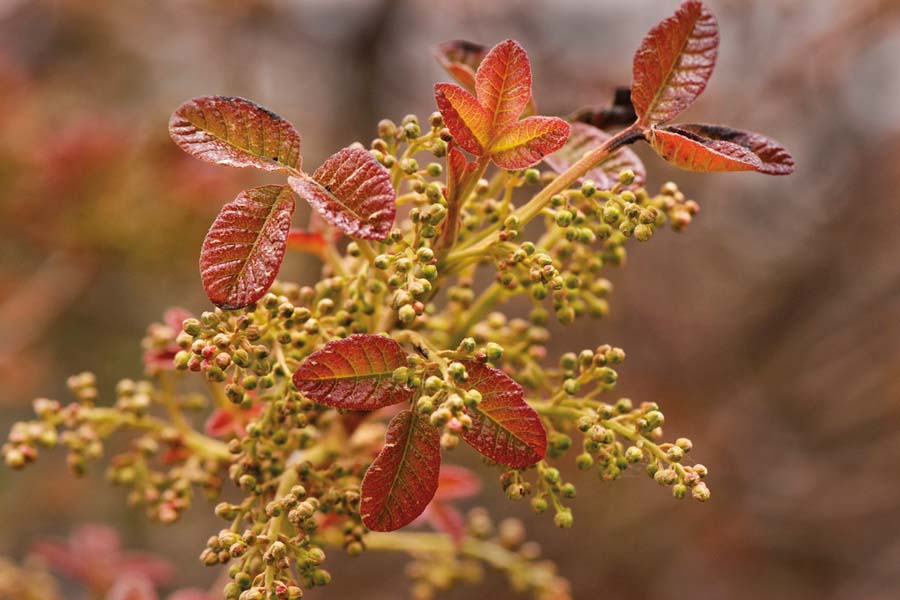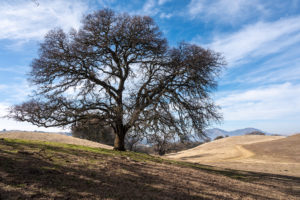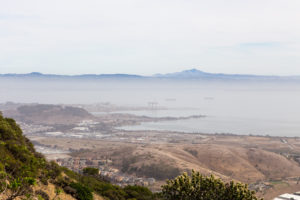When East Bay creek restoration expert Susan Schwartz of Friends of Five Creeks goes to work removing invasive weeds in Tilden Regional Park, she suits up: old knee socks on her arms, gloves, long pants, sometimes even old rain gear. What horrors lurk in our hills? There’s only one plant that inspires that sort of response: poison oak.
Schwartz and her crews actually have a pretty mild attitude toward the plant. “We do get small rashes, often in odd places. We just live with it and use the usual creams and lotions.”
If you haven’t achieved her level of calm acceptance, one obvious question is, “What is poison oak good for?”

Like Pretty Boy Floyd, the bank robber who helped the poor, Toxicodendron diversilobum does provide sustenance. Birds eat its berries: quail, turkeys, woodpeckers, corvids, chickadees, bushtits, waxwings, thrushes, mockingbirds, thrashers, wrentits, warblers, sparrows, towhees, juncos, finches. Black-tailed deer browse the leaves, stems, and twigs, as do wood rats and pocket mice. Domestic goats, including the Goats-R-Us herds that clear brush in the East Bay Regional Parks, eat it enthusiastically; cattle, less so. Horses? We bear personal witness: Some love it and will sneak a mouthful along the trail and then slobber all over their bits. Yuck.
Some insects are also poison oak consumers. The larvae of several moth species eat the leaves and shelter in them when they pupate. A survey in the Santa Cruz Mountains tallied 15 insect orders on poison oak but didn’t record whether they were eating or just passing through. Native bees gather nectar from poison oak, as do introduced honeybees; the resulting honey is bitter but nontoxic.
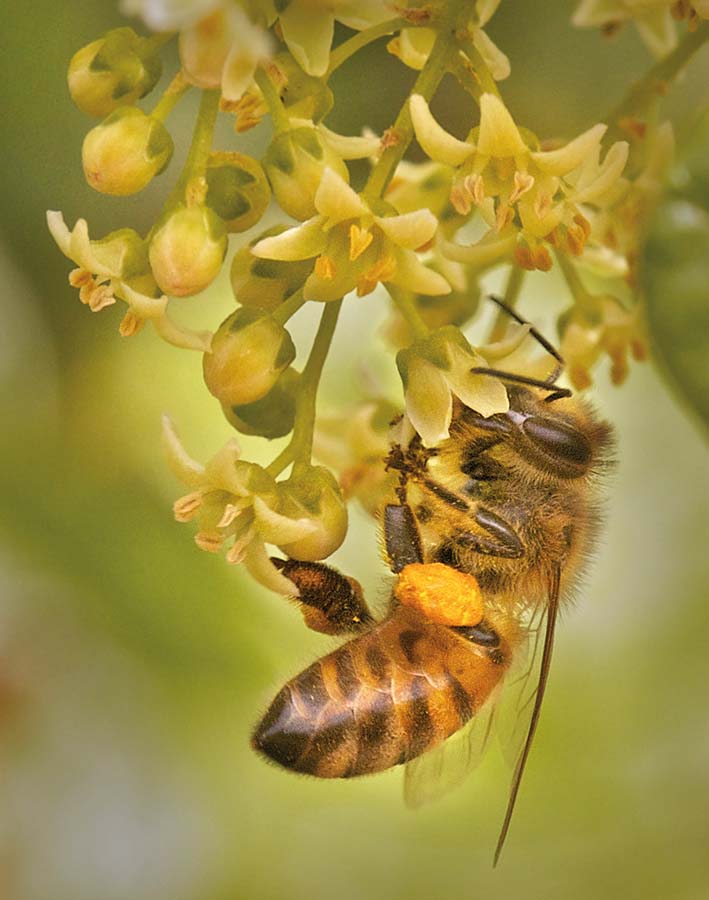
California Indians had many uses for the plant, some surprising. Several groups, including the Ohlone, prized its stems for basketry warp; Wappo weavers dyed baskets with the sap. The Coast Miwok, Kashaya Pomo, and Maidu made tattoo ink from its ashes. Poison oak could also be an ingredient or otherwise involved in cooking. In the 1920s, Rumsen Ohlone members told J. P. Harrington that poison oak was “used with bread,” probably acorn bread. Mamie Offield and Georgia Orcutt, two Karok women interviewed in 1939, said their people roasted soaproot bulbs wrapped in its leaves and smoked salmon on poison-oak skewers, which imparted a distinctive taste. Medicinal applications included treating warts, corns, calluses, and skin cancers with the sap (Chumash); boiling the roots into a tea for diarrhea (also Chumash); and using an unspecified part of the plant as an antidote for rattlesnake venom (Wappo).
Those culinary and medicinal uses may strain credulity–Indian groups also had remedies for poison oak rashes, indicating that they weren’t immune to the toxin. But extreme remedies abound in other medical traditions (bloodletting, anyone? cupping?). It’s possible that some individuals either enjoyed natural poison oak immunity or developed a tolerance through exposure; that may also have been true of particular local communities. (And, it must be said, some ethnographic references may have resulted from miscommunication.)

The first European to notice western poison oak appears to have been Thaddeus Haenke, a Bohemian naturalist on a Spanish expedition to the California coast in 1791, but he confused it with the poison ivy of eastern North America. (There’s also an eastern poison oak, as well as poison sumac and several East Asian relatives; diversilobum is the only West Coast native in the genus.) The plant, which is not an oak at all though its leaves can seem oak-leaf-shaped, was recognized as a distinct species only in the 19th century, described from a type specimen collected in Oregon. Two British naturalists, Alexander Collie and George Lay, may have encountered it on the Monterey Peninsula in 1827; one source says their captain, Frederick Beechey of HMS Blossom, took specimens back to England.
Although the Spanish knew it well enough to call it yiedra maligna (evil ivy), early references to poison oak are sparse. “A possible conclusion is that the plant was less common several centuries ago,” suggests botanist William Gillis, who taught at Michigan State University. “Because Toxicodendron diversilobum is a plant which increases in abundance with disturbance, it is likely that it has become more abundant with the activities of man in clearing the countryside, especially changing fire frequency.”
Preeminent California botanist Willis L. Jepson, who seemed grudgingly respectful of diversilobum, noted its adaptability in 1936: “It has a wider geographic range than any California shrub and grows under a greater variety of soil conditions than any other; though usually preferring good soil or rich loams, it grows in blue adobe, in saline soils, in gray clays, in sandy flats, in heavy gravel deposits and in the crevices of outcropping rock piles. It is also adapted to a greater range of rainfall and temperature than any other California shrub and is especially remarkable for its extreme shade tolerance and its tolerance of intense insolation [exposure to sun].”
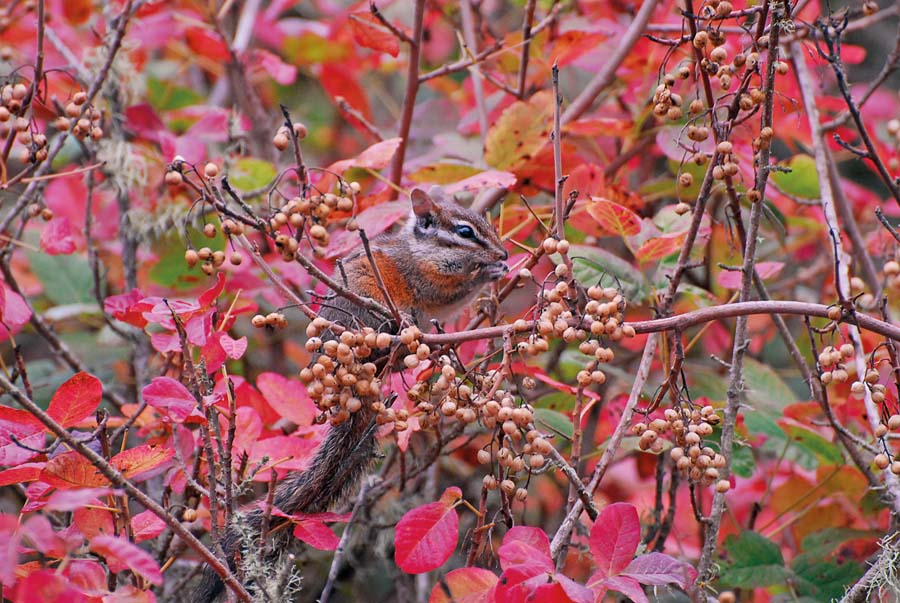
James Roof, the founding director of the Regional Parks Botanic Garden, called T. diversilobum “California’s most beautiful and reliable fall-color shrub. It has only one drawback; it’s deciduous.”
Poison oak is also celebrated every September in a festival in the quasi-ghost town of Columbia, California, at the historic St. Charles Saloon, with awards for best poison oak arrangement, most potent-looking leaves, best poison oak accessory or jewelry, most original poison oak dish (with recipe), and best rash, documented either photographically or in person.
So it is good for something. But it also causes lots of pain.
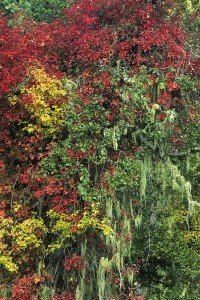
The plant’s named Toxicodendron –“poison tree”–for a reason. Sap laden with the toxin urushiol lurks in resin canals in the stems, leaves, flowers, and roots. Dry winter stems remain potent. Poison oak ash is a major hazard for firefighters, especially if inhaled. Oddly, the pollen doesn’t contain urushiol. Neither do the seasonally fallen leaves; the chemical is drawn back into the sap before the plant sheds them.
Urushiol is in fact an allergen, like the chemicals that cause reactions to mulberry pollen or cat dander. It binds to specialized white blood cells in the skin, triggering a long-lasting immune-system reaction. T-cells rush to the site, broadcasting enzymes and toxins that attack the compromised cells and everything else in the neighborhood like an overzealous swat team. Collateral damage includes redness, itching, and blisters. Different Toxicodendron species have different urushiol types, but the effects are the same. Urushiol is long-lasting; hundred-year-old herbarium specimens have caused rashes.
A poison oak attack is more than just a nuisance. In 1994, William Epstein, a http://baynature.org/wp-admin/post.php?post=86496&action=editdermatologist at UC San Francisco, wrote that poison oak dermatitis caused “significant disability and time lost from work” in California, with costs accounting for one percent of the state’s workers’ compensation budget. Forestry workers and firefighters had the highest incidence of disability.
Only humans and a few fellow primates are naturally susceptible to urushiol dermatitis. An estimated quarter of the U.S. population experiences severe symptoms after contact with the closely related poison oak, ivy, or sumac; another 10 to 15 percent are tolerant. The rest of us react with varying degrees of itching and discomfort. But children under five are less easily sensitized.
Native Americans are no less vulnerable than other ethnic groups. Several Californian treatments for poison oak rash are recorded: pulverized bracken fronds (Yurok, Karok, Tolowa), mashed soaproot (Wintu), mugwort and tule ashes (Chumash), boiled yerba santa and manzanita leaves, mule’s-ear roots. The Esselen of Big Sur are reported to have fed their children poison oak leaves to develop immunity; Euell Gibbons of wild asparagus fame claimed that worked for him and for loggers he knew in the Pacific Northwest.
In his book Poison Ivy, Poison Oak, Poison Sumac and Their Relatives, Edward Frankel provides a dizzying list of home remedies for urushiol rash: “ammonia, baking soda, bleach, buttermilk, castor oil, coffee, cornstarch, Epsom salts, gasoline, goat’s milk, gunpowder, hairspray, horse urine, iodine, kerosene, Lysol, marshmallow, meat tenderizer, nail polish, oatmeal, sodium bicarbonate, strychnine, tobacco, toothpaste, whiskey, and last but not least, zirconium.”
Such a list, dermatologist Albert Kligman observes, “clearly reveals the profound emotional effects of therapeutic desperation.” And that list doesn’t even cover at least a dozen other folk remedies we’ve heard about, from wet cement to darkroom chemicals.
For getting the resin off your skin, some swear by Tecnu–a commercial blend of mineral spirits, water, chemicals, and fatty acid soap invented in the 1960s to remove radioactive fallout from human skin. A study by Adam Stibich and colleagues reported that Tecnu is 70 percent effective at removing plant oils, better than the industrial hand cleaner Goop (62 percent) and standard Dial soap (56 percent).
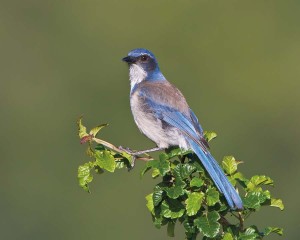
Avoidance is the best strategy. Unfortunately, the familiar mnemonic rhymes can’t always be trusted. “Red touch yellow, kill a fellow” is helpful for coral snakes but “Leaves of three, let it be” is less reliable with poison oak: Some populations have five leaflets–or more. The apparent record is 17. But most of the time, going by the triplets of lobed leaves is a reasonable rule of thumb.
Leaf shape is what you might expect of a plant called diversilobum: The leaves can be flat or curled, symmetrically lobed, asymmetrically lobed, or lobeless. They have a sheen, but they’re not smooth; they have texture, but they’re not heavily veined or crinkled. A typical color sequence goes from pale green spring leaves to the scarlets and purples of fall, but red leaves can be found in any season. Diversilobum is usually a shrub, but given the opportunity, it can climb walls and trees like poison ivy or grow low like a ground cover. It’s tempting to invoke Justice Potter Stewart’s pornography test: “I know it when I see it.” If you don’t know it when you see it, likely the best way to learn is to have somebody show you, and show you again; a search image develops in time.
Fortunately or not, you’ll have lots of opportunity to test your knowledge, as poison oak is ubiquitous in our parks and open space, including throughout the East Bay hills. The park district doesn’t try to eradicate it; it is, after all, a native plant. Maintenance chief Kelly Barrington says his crews just cut it back if it impinges on buildings or trails.
According to Jepson, “In number of individuals, poison oak exceeds, in our judgment, any other shrub species in California.” We couldn’t find supporting surveys or estimates (and plant individuality is a tricky thing, given all those aspen and creosote bush clones). Maybe it just seemed that way to Jepson. It’s widespread for sure: It is recorded in 50 of the state’s 58 counties.

Beyond its tolerance for a range of physical conditions, poison oak owes some of its success to animal accomplices. No one seems to have monitored the insect traffic at a flowering poison oak, but it’s safe to assume there are native pollinators. Common insects like soldier beetles, long-horned beetles, checkered beetles, burrowing bees, and sweat bees are known to pollinate poison ivy; representatives of most of these families have been found on poison oak. Birds that eat the berries may unload them some distance away, where the seeds can germinate in fresh territory. Flickers have a prodigious appetite for poison-ivy fruit (up to a quarter of their diet in some cases) and likely consume a comparable amount of poison-oak berries. Other migratory birds may also be significant seed dispersers.
Poison oak is limited by altitude, though, growing no higher than 5,000 feet; Yosemite Valley is free of it. One of the first bits of California biogeographical lore we picked up decades ago was that you didn’t have to worry about rattlesnakes or poison oak in the High Sierra.
That may not be reliable for much longer. Lewis Ziska of the U.S. Department of Agriculture’s Agriculture Research Service and Jackie Mohan of the University of Georgia have studied the response of eastern poison ivy to climate change. In field and lab settings, their test plants were active for a longer part of the year under warmer temperatures and higher carbon dioxide levels. What’s more, their urushiol became more poisonous. “I would say it’s legitimate to extend our work to other Toxicodendron species, including T. diversilobum,” says Mohan. “In fact, the urushiol standard we used for analysis was from poison oak; it’s the same chemical.”
In a warmer world, this botanical opportunist may climb the mountains of California. Then there will be no escape!
PO’d by Poison Oak
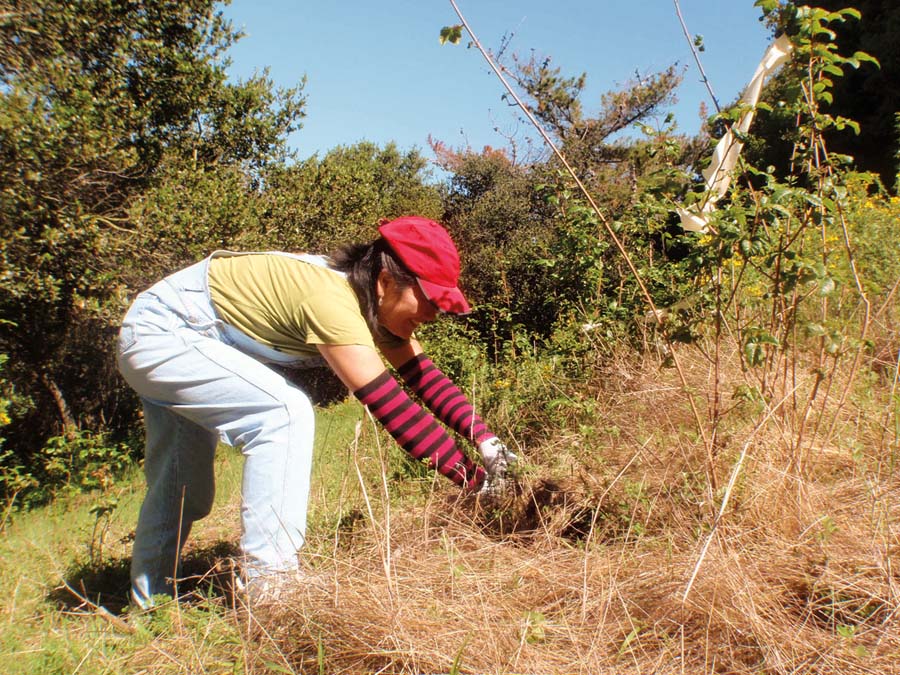
A very unscientific survey revealed assorted experiences and remedies among people who’d got their thumbs into it.
“I got bad cases as a young child,” says Regional Parks Botanic Garden director Steve Edwards. “Then I was nonreactive for about 30 years, often bushwhacking through it with no effect. Then I got a case out of the blue.” Others on his staff are more reliably allergic: “Some swear by Tecnu, but they like Dawn dish soap even better. We agree that a thorough wash with soap and water as soon as possible after exposure helps, as well as throwing your clothing in the wash to avoid spreading the affliction.”
Landscape architect Chris Grampp wasn’t even out in the wild landscape when he got a rash; he just leaned against a neighbor’s handmade wooden fence. The wood was eucalyptus, salvaged from a poison-oak-infested patch of Claremont Canyon. Grampp wound up in the hospital. On another occasion, he took the advice of a friend who suggested a post-exposure hot bath–which distributed the urushiol uniformly over his entire body. Back to the hospital.
Park district botanist Wilde Legard usually manages to avoid rashes by rinsing off soon after exposure (in a creek or with water he’s carrying). He also says a product called Ivy Block is widely used by U.S. Forest Service workers to prevent rashes, and the pricey Zanfel ($40 an ounce) and its less expensive generic cousins do a good job of treating rashes.
Poison oak is part of the territory for trail builders and habitat restoration workers. “It’s an occupational hazard in stream restoration,” says Ann Riley, a river and watershed adviser for the San Francisco Bay Regional Water Quality Control Board. “It got to the point where all I would have to do is touch the plant and it would go through my skin and be carried by my bloodstream throughout my body so that I would have to spend a few days in bed in agony and be out of work for a week.” Injections of a poison ivy extract stopped her systemic reaction.
A friend of ours who worked in Redwood Regional Park claims his poison oak rash inspired the park system’s current requirement that employees wash their hands before using the bathroom.
Ron Sullivan and Joe Eaton are nature fiends who live in Berkeley and write “The Dirt,” a garden column appearing irregularly in the San Francisco Chronicle. Joe also contributes to Estuary News.
Habitats of the East Bay Regional Park District This story is part of a series exploring significant natural habitats and resources of the East Bay Regional Park District (EBRPD), many of which are encountered in other parts of the Bay Area as well. The series is sponsored by EBRPD, which manages 65 parks, reserves, and trails covering more than 100,000 acres in Alameda and Contra Costa counties (ebparks.org).

